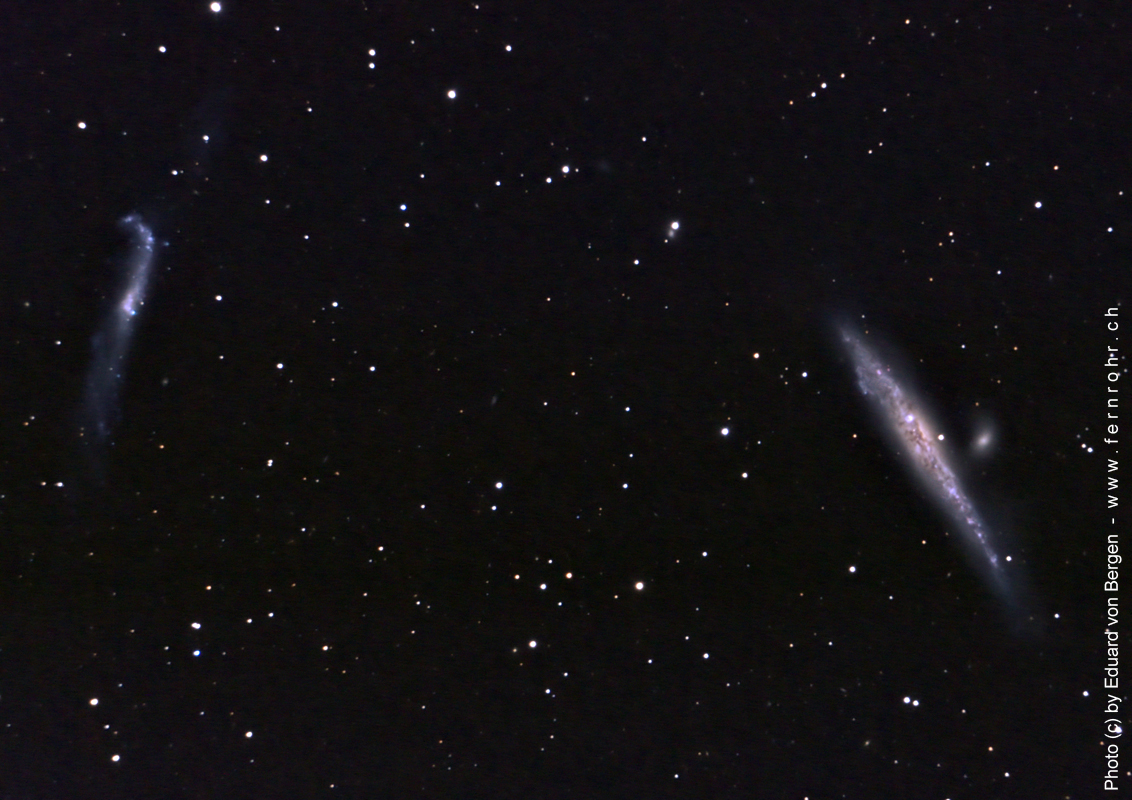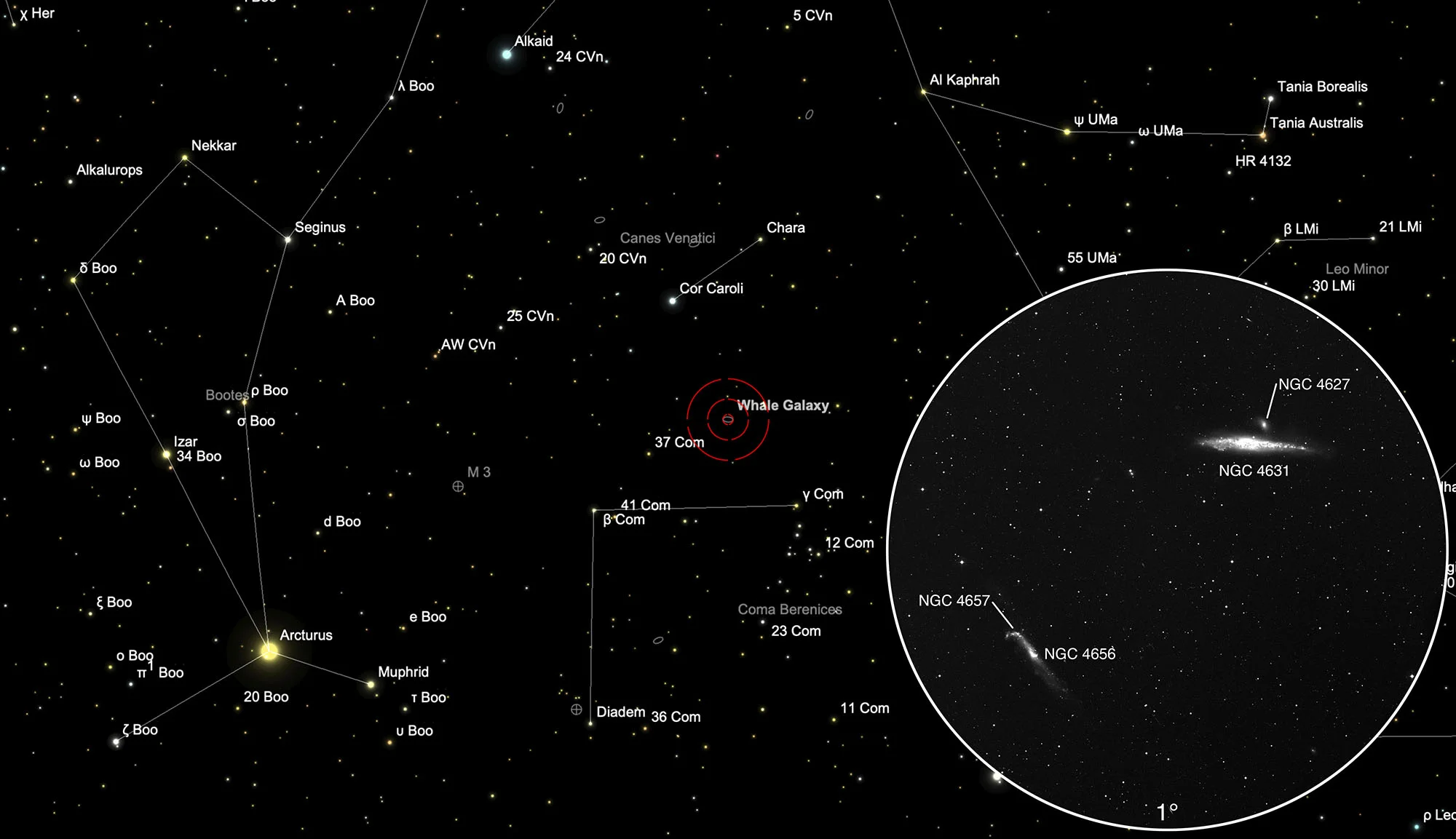Whale Galaxy (NGC 4627/31) with Hockeystick (NGC 4656/7)

Walgalaxie NGC 4631 + NGC 4627
The galaxy NGC 4631 has been nicknamed the «Whale Galaxy» because of its slightly asymmetrical shape. In fact, in Figure 2, it looks like a humpback whale swimming upwards. One believes to recognize the flipper (pectoral fin) and fluke (tail fin). The intergalactic mammal was first sighted by William Herschel on 20 March 1787. It is a spiral galaxy that we are looking at closely on the side edge. Distances vary from 18 to 30 million light years. Assuming a distance of 25 million light years, the diameter of the galaxy is about 120'000 light years. The galaxy is in gravitational interaction with neighboring dwarf elliptical galaxy NGC 4627 and galaxy NGC 4656, less than 500'000 light-years away, which can be seen almost half a degree to the southeast. [196]


The small galaxy NGC 4627 was discovered on 20 March 1787 by the German-British astronomer William Herschel. It is a dwarf elliptical galaxy and a companion of NGC 4631. Both galaxies show mutual interaction and are listed in the Arp catalog [199] under the number (Arp 281) as double galaxies with inflow and attraction. It can be seen at the top of NGC 4631 in Fig. 3. [196]
Hockeystick Galaxy NGC 4656/7

On 20 March 1787, William Herschel came across this object for the first time. John Louis Emil Dreyer saw it as two separate nebulae and gave them the numbers 4656 and 4657 in his «New General Catalogue». Because of its asymmetric shape, this galaxy has also been nicknamed the Hockey Stick or Crowbar. In the «Catalogue of Principal Galaxies» (PGC) [144] the two are listed as one and the same galaxy (PGC 42863).
According to LEDA [134], the galaxy is moving away from us at a speed of 646±4 km/s. The calculated distances are in the range of 15 to 30 million light years.
NGC 4657 is a bright area of intense star formation with luminous stars and nebulae within galaxy NGC 4656, presumably formed by past gravitational interaction with galaxy NGC 4631, less than half a million light-years away. At a distance of approximately 25 to 30 million light years, the angular diameter of about 2 x 1 arc minutes corresponds to a true size of 7000-8000 light years. In Fig. 4, another faint structure can be seen to the north of the galaxy, which appears to be associated with NGC 4656. [196]
| Name | RA | Dec | Type | bMag | vMag | B-V | SB | Dim | PA | z | D(z) | MD | Dreyer Description | Identification, Remarks |
|---|---|---|---|---|---|---|---|---|---|---|---|---|---|---|
| NGC 4627 | 12 41 59.6 | +32 34 26 | Gx (E4/P) | 13.1 | 12.4 | 0.7 | 14.1 | 1.7 × 1 | 26 | 0.001808 | 7.64 | 9.380 | F, S, R, np of 2 | WH II 659; h 1391; GC 3159; UGC 7860; MCG 6-28-19; CGCG 188-15; Arp 281; KUG 1239+328A |
| NGC 4631 | 12 42 07.6 | +32 32 30 | Gx (SBcd) | 9.8 | 9.2 | 0.6 | 13.1 | 15.2 × 2.8 | 86 | 0.002021 | 8.54 | 6.050 | !, vB, vL, eE 70° ±, bMN, * 12 att n | WH V 42; h 1397; GC 3165; UGC 7865; MCG 6-28-20; CGCG 188-16; IRAS 12396+3249; KCPG 350A; Arp 281; KUG 1239+328B; Whale Galaxy |
| NGC 4656 | 12 43 58.1 | +32 10 11 | Gx (SBm) | 11.0 | 10.5 | 0.5 | 14.5 | 15.3 × 2.4 | 33 | 0.002155 | 9.10 | 6.330 | !, pB, L, vmE 34°, sp of 2 | WH I 176; h 1414; GC 3189; UGC 7907; MCG 5-30-66; CGCG 159-65; IRAS 12417+3228; KCPG 350B; FGC 174A; KUG 1241+324 |
Finder Chart
The galaxy group is located in the constellation Canes Venatici near the border of Coma Berenices. The 4.9 mag star 37 Comae Berenices serves as a guide.
Visual Observation

350 mm aperture: In a large field eyepiece, the four galaxies provide an impressive view of the depths of space and their diversity. On the one hand, there is a cannibalizing and strongly graphically influencing pair of galaxies. Next is a bright cigar-shaped galaxy with what appears to be a small, rounded companion. The last-mentioned, small galaxy is about three times deeper in space. It is worth looking at all four galaxies with one look in a large field eyepiece. The details of the 13.3 mag, 9.8 mag and approx. 10.7 mag bright galaxies are clearly visible in a medium magnification. — 14" PWO-Dobson, F:4.6 / TV-Nagler 31mm, 52x, 1.6° und TV-Nagler 13mm, 123x, 0.67°, Eduard von Bergen
400 mm aperture: With a 21 mm Tele Vue Ethos eyepiece (85x) both big galaxies fit into the same field of view and are pretty impressive thanks to their different shapes. The galaxies were near zenith at that time of the night and showed high contrast and structure. The small companion NGC 4627 of the Whale Galaxy NGC 4631 is easily visible. So also is the odd shape of the Hockey Stick Galaxy. With higher magnification structure and dust lanes of NGC 4631 become visible. — Taurus T400 f/4.5 Dobsonian, Bernd Nies, Glaubenberg Langis, 28 February 2022
